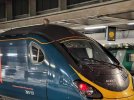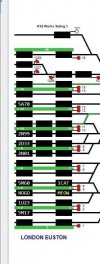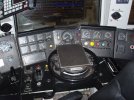-
Our booking engine at tickets.railforums.co.uk (powered by TrainSplit) helps support the running of the forum with every ticket purchase! Find out more and ask any questions/give us feedback in this thread!
You are using an out of date browser. It may not display this or other websites correctly.
You should upgrade or use an alternative browser.
You should upgrade or use an alternative browser.
Driving a train with minor irritations
- Thread starter Paul Jones 88
- Start date
- Status
- Not open for further replies.
Sponsor Post - registered members do not see these adverts; click here to register, or click here to log in
R
RailUK Forums
They did indeed. A number of older German types used them too.I always assumed the 'steering wheels' were a French thing, or at least an Alstom thing. The earlier TGVs all had them I believe?
Are any of them combined throttle/brake controllers though? All the ones I've seen have been throttle only, with conventional brake controls adjacent.Some of the European trains and locos have a brake / throttle control that looks to all intents and purposes like a steering wheel....
This is the cab of a DB Series 103 loco, for example:

File:Führerstand Baureihe 103.jpg - Wikimedia Commons

In these locos the driver uses the wheel to select one of 39 power notches, which is then matched by the tap-changer. The button in the middle is the fast run-down (and not the horn, to my disappointment
craigybagel
Established Member
- Joined
- 25 Oct 2012
- Messages
- 5,077
Not heavy rail, but the Trams in Zurich use a wheel controls both power and brake.Are any of them combined throttle/brake controllers though? All the ones I've seen have been throttle only, with conventional brake controls adjacent.
More specifically a Great Britain thing. The cabs of the NIR 3000 and 4000 class DMUs look very similar to any other generic multiple unit from the UK, complete with AWS and TPWS. But if you look closely, you'll see the Power/Brake controller is push forward for Power.It's more a UK thing, Europe is normally power forward/brake backwards.
hexagon789
Veteran Member
Yes, and that is standard on IÉ DMUs as well I believe. However the withdrawn NIR DEMUs adhered to UK convention albeit with separate brake and power handles.More specifically a Great Britain thing. The cabs of the NIR 3000 and 4000 class DMUs look very similar to any other generic multiple unit from the UK, complete with AWS and TPWS. But if you look closely, you'll see the Power/Brake controller is push forward for Power.
Wilts Wanderer
Established Member
- Joined
- 21 Nov 2016
- Messages
- 2,483
Is it right to say that LU stock design has always settled with the deadman’s handle rather than pedal tradition because of the number of motormen who prefer to drive from the standing position? Presumably this is no longer possible with the most modern trainsets.
hexagon789
Veteran Member
I imagine it's because older multiple units usually had the deadman's incorporated into the power handle and it made sense to perpetuate this design rather than switch to a foot pedal.Is it right to say that LU stock design has always settled with the deadman’s handle rather than pedal tradition because of the number of motormen who prefer to drive from the standing position? Presumably this is no longer possible with the most modern trainsets.
They did indeed. A number of older German types used them too.
Are any of them combined throttle/brake controllers though? All the ones I've seen have been throttle only, with conventional brake controls adjacent.
This is the cab of a DB Series 103 loco, for example:

File:Führerstand Baureihe 103.jpg - Wikimedia Commons
commons.wikimedia.org

In these locos the driver uses the wheel to select one of 39 power notches, which is then matched by the tap-changer. The button in the middle is the fast run-down (and not the horn, to my disappointment)
On some (RhB GE4/4 IIIs spring to mind) Rheostatic braking is obtained by turning the wheel the other way.
craigybagel
Established Member
- Joined
- 25 Oct 2012
- Messages
- 5,077
Almost - it's that way on IÉ EMUs (ie the entire DART fleet). So far every DMU built for IÉ has had seperate brake and power handles.Yes, and that is standard on IÉ DMUs as well I believe. However the withdrawn NIR DEMUs adhered to UK convention albeit with separate brake and power handles.
hexagon789
Veteran Member
That's probably what I was thinking of thenAlmost - it's that way on IÉ EMUs (ie the entire DART fleet). So far every DMU built for IÉ has had seperate brake and power handles.
I'm just reminded that in San Francisco, USA, they had a large fleet of 1940s trams on the street, the PCC type, which were controlled by two pedals, right for power and left for brake. Nothing for the hands to do. They lasted into the 1980s, in fact they still have several around.AIUI that's only on National Rail. ISTR LT still have the dead mans handle incorporated in the traction brake controller which is the opposite way around to National Rail. i.e. push forwards to apply power and pull back to brake.
But in the 1970s they bought some secondhand ones from the Cincinnati system, which had closed down. Same manufacturer, looked the same, got repainted in the San Francisco livery. But they had a range of customised differences, a principal one being that Cincinnati had done the pedals the other way round - left for power, right for brake. They were put into full service without modifying this at all, with the same set of drivers. It's difficult to imagine a more dangerous position that the management could not initially see.
bramling
Veteran Member
Is it right to say that LU stock design has always settled with the deadman’s handle rather than pedal tradition because of the number of motormen who prefer to drive from the standing position? Presumably this is no longer possible with the most modern trainsets.
It’s possible to driving standing up on most LU stocks. 92, 95 and 96 are the exception - it is still possible, but only by either standing behind the seat and crouching down, or standing in the centre of the cab and driving with the left hand. Neither of these positions are particularly pleasant, but a small number of drivers drive thus.
S stocks are also odd to drive standing up as the floor slopes, but presumably people get used to this over time.
Driving standing up is much less common on LU nowadays than in the past. Firstly some of the current trains aren’t really designed for it as described above, but also drivers seats have tended to get more comfortable (proper armchair instead of tip-down seat).
Not sure about 09 stock as that’s an oddball, not least having a right-hand driving position.
philthetube
Established Member
- Joined
- 5 Jan 2016
- Messages
- 3,762
S stock was specifically designed, at union request, to be driveable standing, and is actually very comfortable to do, the sloping floor is actually the footrest, and is not stood on when driving. The tip us seat acts as a back rest and the seat being moved forward or back changes the standing position in relation to how close to the controls the driver stands, the cab is very well designed from that viewpoint.Is it right to say that LU stock design has always settled with the deadman’s handle rather than pedal tradition because of the number of motormen who prefer to drive from the standing position? Presumably this is no longer possible with the most modern trainsets.
choochoochoo
Established Member
- Joined
- 6 Aug 2013
- Messages
- 1,215
I loved being able to drive 313s standing up. Wish it was possible in 717s. I'm sure some savvy drivers must have figured a way of doing this.S stock was specifically designed, at union request, to be driveable standing, and is actually very comfortable to do, the sloping floor is actually the footrest, and is not stood on when driving. The tip us seat acts as a back rest and the seat being moved forward or back changes the standing position in relation to how close to the controls the driver stands, the cab is very well designed from that viewpoint.
Also 313s dual deadmans pedal and handle was nice. It didn't have a vigilance device.
I think the Re 450 do too - admittedly the wheel isn't fully round though. Can be seen in this cab ride video:Not heavy rail, but the Trams in Zurich use a wheel controls both power and brake.
Still see a fair few drivers on Merseyrails 507/8s that stand up whilst driving. They're fitted with a small brass foot pedal to the right if I remember correctly that can be pressed instead of holding the deadmans handle down to avoid achey wrists.I loved being able to drive 313s standing up. Wish it was possible in 717s. I'm sure some savvy drivers must have figured a way of doing this.
Also 313s dual deadmans pedal and handle was nice. It didn't have a vigilance device.
They arnt fitted with vigilance device either.
delticdave
Member
- Joined
- 14 Apr 2017
- Messages
- 449
That's an interesting comparison, but all the automatic transmission cars that I've driven (in manual mode) it's backwards to change down, forwards to change up. In a manual car, shifting is done via a gate, so shifting up or down can be backwards or forward.It is and it isn’t.. if you think of the momentum forces involved (you’re pushed back when accelerating and vice versa) it makes sense. It’s the same with modern car gearbox’s. Pull back to change up a gear and push forward to change down.
With most modern European locos & MU's, it's forwards to go, backwards to stop.
slidingdoors
Member
- Joined
- 15 Apr 2017
- Messages
- 143
Yeah you’re right with autos on the whole I guess. But sporty motors such as BMWs and Porsches etc are pull back to change up / forward to change down. maybe it’s more a dual clutch thing rather than standard autos. Although DSG cars work like standard autos so that contradicts. Sorry off topic anyway.
Aventra EMUs are pull back to accelerate.
Also the Millennium Falcon is pull back to accelerate so that should end the debate as to what’s right :P
Aventra EMUs are pull back to accelerate.
Also the Millennium Falcon is pull back to accelerate so that should end the debate as to what’s right :P
Steddenm
Member
Would this be classed as an irritant...


[Taken from https://twitter.com/TheDriverG/status/1366885687186849796?s=19]


[Taken from https://twitter.com/TheDriverG/status/1366885687186849796?s=19]
Yeah you’re right with autos on the whole I guess. But sporty motors such as BMWs and Porsches etc are pull back to change up / forward to change down. maybe it’s more a dual clutch thing rather than standard autos. Although DSG cars work like standard autos so that contradicts. Sorry off topic anyway.
Aventra EMUs are pull back to accelerate.
Also the Millennium Falcon is pull back to accelerate so that should end the debate as to what’s right :P
All British trains are pull back to accelerate.
the sniper
Established Member
- Joined
- 4 Sep 2007
- Messages
- 3,499
Yeah you’re right with autos on the whole I guess. But sporty motors such as BMWs and Porsches etc are pull back to change up / forward to change down. maybe it’s more a dual clutch thing rather than standard autos. Although DSG cars work like standard autos so that contradicts. Sorry off topic anyway.
Same with most racing/rally cars. The reasoning being that under heavy braking, the driver's forward inertia makes changing down pushing forward easier. You're not counteracting the force you're experiencing. To me, BMW and Porsche's way is the better way, whereas most manufacturers have gone with the more simple 'forward to go' concept.
bussikuski179
Member
We’ve (in Finland) had them on plenty of trains, the Dr13 from Alstom had it, the Sr1 built in Russia has it, the Valmet built Sm1 and 2 has it too. The Dr12 might have it too, but I’m absolutely not sure about that.I always assumed the 'steering wheels' were a French thing, or at least an Alstom thing. The earlier TGVs all had them I believe?
There is a similar tale in broadcasting. Most microphone faders are push away to fade up. But the BBC has always been upside down, pull down to fade up. The story being that if you die on air you will slump onto the controls, push them forward and fade yourself off air. I suspect folklore like this is the same with the the cab controls: a useful coincidence, but not the reason for the design.I believe the idea of pushing forward for brake is that if the driver takes ill and collapses onto the controls, in theory they should knock the brakes on rather than the power, just in case their weight is still on the DSD.
flitwickbeds
Member
- Joined
- 19 Apr 2017
- Messages
- 525
I still do this job for the BBC, and experienced "fade down to open" faders in Bush House before that closed. The tale I was told was that in the olden days, Studio Managers wearing dinner jackets with thick cuffs would accidentally open adjacent faders when reaching for the correct fader because their sleeves would catch the fader.There is a similar tale in broadcasting. Most microphone faders are push away to fade up. But the BBC has always been upside down, pull down to fade up. The story being that if you die on air you will slump onto the controls, push them forward and fade yourself off air. I suspect folklore like this is the same with the the cab controls: a useful coincidence, but not the reason for the design.
I used to think this was rollocks... until one day it happened to me wearing a fleece!
Rick1984
Member
- Joined
- 23 Aug 2012
- Messages
- 1,034
That's interesting. Why haven't they switched to combined power handles?So far every DMU built for IÉ has had seperate brake and power handles.
Last edited:
craigybagel
Established Member
- Joined
- 25 Oct 2012
- Messages
- 5,077
Good question (assuming you were indeed asking a question and just forgot to add a question mark).That's interesting. Went haven't they switched to combined power handles
I don't know the official answer but I suspect it was because the first "modern" DMUs Irish Rail bought were the Japanese built 2600 class - and from what I've seen the cab layout in these is pretty similar to other Japanese DMUs of that era. All the other DMU that have come since have had similar layouts which presumably makes training easier.
I'm not entirely convinced one system is better than the other anyway. I drive DMUs in the UK with both combined and separate power and brake handles and whilst they both have pros and cons, I'm not convinced either design stands out as better or worse.
66s and 67s ain’tAll British trains are pull back to accelerate.
And 70's66s and 67s ain’t
Rather depends on what part of a plane you're pushing and pulling. If its the throttle then this is generally inaccurate in its most basic form.boats and planes, push forward to go forward, pull back to slow down. (The last bit even applies to horses)
Same with most racing/rally cars. The reasoning being that under heavy braking, the driver's forward inertia makes changing down pushing forward easier. You're not counteracting the force you're experiencing. To me, BMW and Porsche's way is the better way, whereas most manufacturers have gone with the more simple 'forward to go' concept.
Cars that have been adapted for hand controls for drivers with disabilities have always (AFAIK) operated under the push forward to brake concept which makes much more sense to me, at least in a road / rail vehicle for the reasons outlined above and in other posts.
Highlandspring
Established Member
- Joined
- 14 Oct 2017
- Messages
- 2,777
And 92s..And 70's
- Status
- Not open for further replies.

